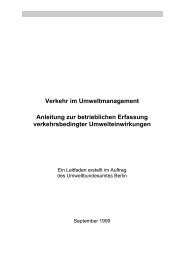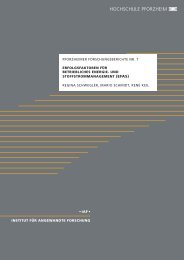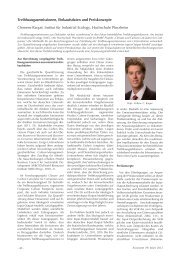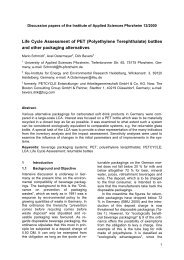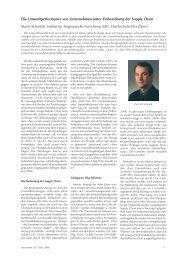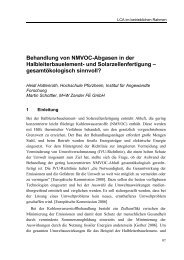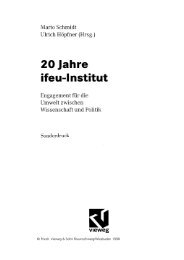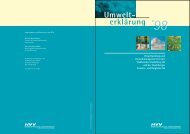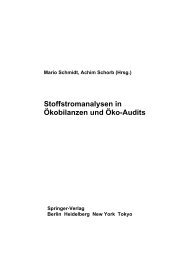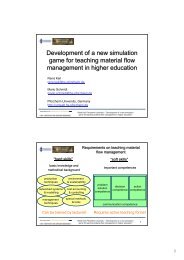article in press - und Umweltmanagement - Hochschule Pforzheim
article in press - und Umweltmanagement - Hochschule Pforzheim
article in press - und Umweltmanagement - Hochschule Pforzheim
You also want an ePaper? Increase the reach of your titles
YUMPU automatically turns print PDFs into web optimized ePapers that Google loves.
ARTICLE IN PRESS2M. Schmidt / Environmental Impact Assessment Review xx (2005) xxx–xxxsociety. Technical <strong>in</strong>novations and customer demand lead to ever shorter product lives.Mobile telephones now have a service life of just <strong>und</strong>er two years. It is generally not worthrepair<strong>in</strong>g defective equipment. Consequently the typical life cycle of an electronicappliance is a l<strong>in</strong>ear progress from production, through use, to waste disposal.The EU’s WEEE Directive (waste of electronic and electrical equipment) obligatesmanufacturers of electronic and electrical equipment to take back old equipment fromcustomers free of charge and to dispose of these wastes <strong>in</strong> an environmentally so<strong>und</strong>manner. The Directive specifies recycl<strong>in</strong>g quotas accord<strong>in</strong>g to which the old appliances ortheir materials must be reused and channelled back <strong>in</strong>to the economic cycle. In this wayl<strong>in</strong>ear material flow management with a throw-away mentality becomes a closed-loopmaterial flow management with a high recycl<strong>in</strong>g target – <strong>und</strong>er duress on the basis ofgovernment stipulations.The closed-loop material flow management is one of the meta-strategies ofsusta<strong>in</strong>able development. Economical handl<strong>in</strong>g of the natural resources of this worldcan be achieved not merely by renunciation, but also by reuse and recycl<strong>in</strong>g of theproducts. Despite this a question still to be answered concerns the price at whichclosed-loop material flow management is possible. Observance of the WEEEstipulations <strong>in</strong>volves costs, which the manufactur<strong>in</strong>g firms naturally want to m<strong>in</strong>imise.Furthermore, for f<strong>und</strong>amental physical reasons a closed-loop material flow managementsystem can never be completely closed and function as a self-conta<strong>in</strong>ed entity.Accord<strong>in</strong>g to the rules of thermodynamics it requires at least energy <strong>in</strong> order tostructure order and reduce the entropy. If this energy is not generated <strong>in</strong> anenvironmentally so<strong>und</strong> manner, e.g. solar energy, there is not necessarily an ecologicalbenefit <strong>in</strong> the closed-loop material flow management system which then depends onthe concrete structur<strong>in</strong>g of the closed-loop system.This makes it clear that <strong>in</strong> future methodology approaches are necessary that allow aholistic analysis of closed-loop material flow management systems <strong>und</strong>er both economicand ecological aspects. Look<strong>in</strong>g at the example of electronic waste, even socialcomponents have to be added. In Germany electrical equipment has so far chiefly beendismantled and recycled by workshops provid<strong>in</strong>g employment for handicapped orchallenged persons. These workshops were granted subsidies by society. However, thestrict stipulations of the WEEE Directive force manufacturers to build up efficient andcost-optimised reverse logistics and recycl<strong>in</strong>g systems. Facilities on a large technical scalewith high-quantity throughputs will be given preference over manual dismantl<strong>in</strong>g bydecentrally distributed social facilities.The problem of the quantitative analysis methods customary so far is that they canhardly be applied for closed-loop material flow management systems. Classic managementtheory focuses on products, not on wastes, that for a long time did not cost anyth<strong>in</strong>g.However, if these are taken <strong>in</strong>to account despite this, then as costs for the establishments oras macro-economic damage, but not as possible secondary raw materials <strong>in</strong> a closed-loopmaterial flow management system. On the other hand environmentally oriented analysessuch as, for example, the Life Cycle Assessment of products and services only consider theimpacts on the environment (ISO, 14.040). Admittedly recycl<strong>in</strong>g systems are analysed ona large scale here too (UBA, 1999), but so far the economic aspect and hence the costshave not been <strong>in</strong>tegrated.



